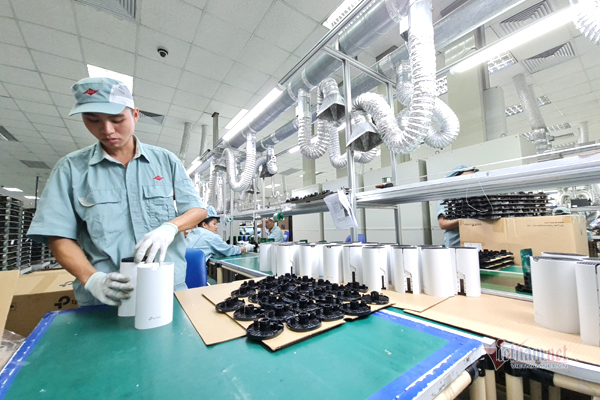 |
Vietnam has been among the economies with high GDP growth rates, 6-7 percent, in the last 20 years. According to the World Bank, from 2002-2018, Vietnam’s GDP per capita increased by 2.7 times to $2,700 in 2019.
However, experts, when analyzing development indicators to predict the growth rates of Vietnam’s economy, noted that the preliminary labor productivity in 2019 was VND110.5 million per worker.
An APO report released in 2019 showed that productivity in 2011-2018 grew by 4.8 percent per annum. The figure inched up in (2016-2018 with an annual increase of 5.7 percent.
Compared with other regional countries, Vietnam has labor productivity increase higher than Singapore (1.42 percent per annum), Malaysia (2 percent), Thailand (3.2 percent) and Indonesia (3.6 percent).
However, the report also pointed out that Vietnamese productivity in accordance to PPP is still very low compared with other regional countries. The productivity per hour of Vietnamese workers is just 1/11.5 of Singapore, 1/4.5 of Malaysia, 1/2.5 of Thailand, 1/2 of Indonesia, 1/1.6 of the Philippines, and 89 percent of Laos.
Vietnam’s magic growth in recent years is attributed to the strategy on developing markets and opening the economy, attracting foreign direct investment and developing production and export bases.
However, to continue to develop, Vietnam needs to escape the strategy that relies on low cost labor force and foreign invested enterprises’ exports, and needs to shift focus on productivity improvement.
Increasing productivity by developing science and technology will be the prerequisite factor for Vietnam to develop its economy.
The analysis of productivity in 2000-2018 by a project on assessing the impact of technological reform in Vietnam on GDP productivity growth in business fields showed that the average output growth rate of every Vietnamese worker was 3.3 percent.
| The analysis of productivity in 2000-2018 by a project on assessing the impact of technological reform in Vietnam on GDP productivity growth in business fields showed that the average output growth rate of every Vietnamese worker was 3.3 percent. |
The labor output was affected by many factors, including capital intensity, labor mobility between industries, ability to absorb technology, and efforts of leading enterprises in industries to apply high technology.
Of these, the absorption of technology has made the greatest contribution to growth, making up 1.8 percent of the total 3.3 percent growth rate.
The report also pointed out that in the last 20 years, if making more investments in technology, most Vietnamese enterprises would be able to come closer to the optimal level that the most effective businesses in the economy can obtain.
Investment in science and technology
Experts believe that improving the technological capability of enterprises is the major driving force which helps push up the output per worker.
Technology application is an important channel of growth. This also shows the importance of policies as a tool to support the improvement of enterprises’ technology absorption capability.
The problem is that the investment in science and technology in Vietnam is still low. In 2017, the investment in R&D in Vietnam just accounted for 0.5 percent of GDP, much lower than the 1.44 percent of Malaysia and 0.8 percent of Thailand.
The low investment rate in R&D both in the state and private sectors, is a concerning issue. The low investments, together with the investors’ skepticism, many come from the belief that productivity to be gained by applying and innovating technology won’t be high.
The direct and indirect impact of the investments in technology in Vietnam on productivity, GDP and economic growth remain speculative.
A study of the Ministry of Science and Technology, VEPR-VNU and Queensland University has pointed out that double investment in R&D within one year could lead to a 1.8 percent growth rate in GDP per capita for 15 years. The highest impact will be noticed about five to 10 years after investments in research and development.
The capital to be invested in R&D will also impact consumption and wage growth, mainly due to the increase in the incomes of skilled and unskilled workers in the economy. In particular, for 15 years, the increase in investment in R&D may lead to an average increase of 2.51 percent in consumption and a 2.48 percent annual increase in investment for the whole economy.
In general, the application of science and technology, innovation and research and development will be the key to Vietnam's economic growth in the next 20-25 years. In that way, technology firms, especially ICT businesses, will be an important push to lead Vietnam’s digital transformation.
Trong Dat

Digital transformation: smart homes invented by Vietnamese
The digital transformation process is being carried out throughout Vietnam, from large enterprises to small shops.

Govt seeks 7.5-8% annual growth in next 25 years via digital transformation push
To become a powerful and prosperous country by 2045, Vietnam needs to obtain a GDP growth rate of 7.5-8 percent per annum for the next 25 years. Only digital transformation can helps make this a reality.
